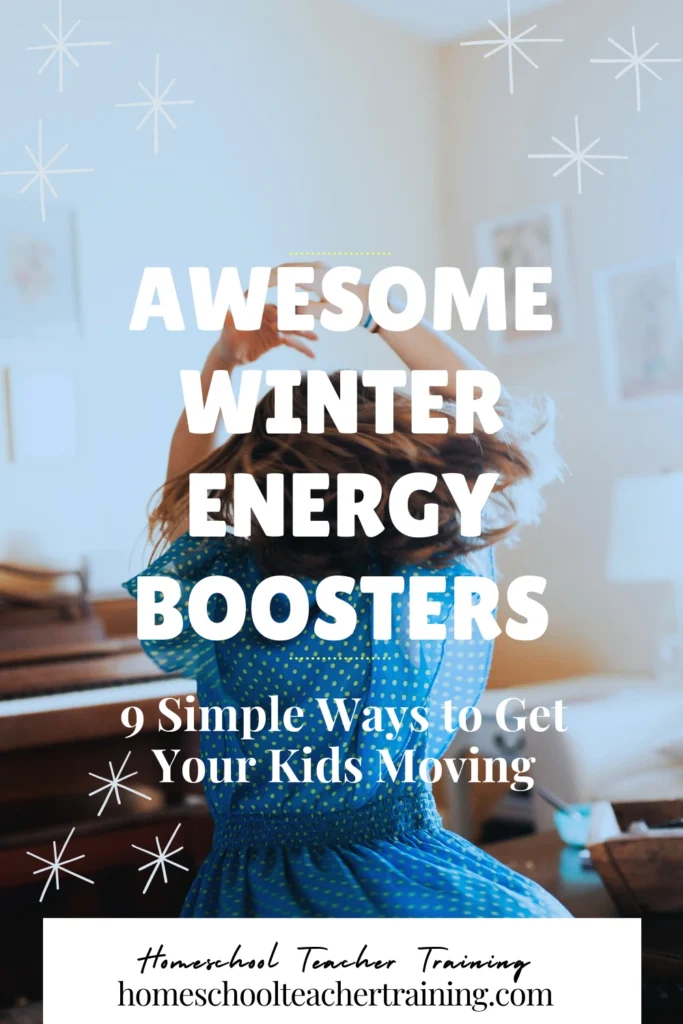Awesome Winter Energy Boosters: 9 Simple Ways to Get Your Kids Moving
Let’s be honest – winter is hard. I live in Canada, where it seems like winter always lasts four months longer than it should. The days are short, dark, and cold, and it’s so tempting to just huddle under blankets until spring comes. But I’ve learned through experience that the more you lie around not moving, the less you want to move. By February, even getting dressed can feel like too much effort.
Meanwhile, kids still need to move. Some need it more than others (I have one child who bounces off walls if she doesn’t get enough physical activity, and another who would happily read on the couch all day like me), but they all need some movement to stay healthy and focused. The good news? You don’t need elaborate equipment or expensive programs to keep your kids moving through the winter months.
Let’s look at nine simple winter energy boosters, with options for different activity levels, interests, and situations. Finding the right winter family activities can make the difference between a long, dreary season and one filled with energy and fun.

Inside Movement
1. Movement Breaks
One of the easiest ways to add movement to your day is through simple movement breaks between activities. Think of these as pressure-release valves – a quick burst of physical activity can reset energy levels, improve focus, and often change the whole mood of your homeschool day.
Try these quick movement boosters:
- Have a two-song dance party between subjects
- Follow a short movement video on YouTube
- Play Simon Says or Freeze Dance
- Do some basic stretches or yoga poses
- Run in place for one minute
The key is to keep these breaks short and fun. You’re not training for the Olympics – you’re just getting blood flowing and energy moving.
2. Simple Indoor Movement Activities for Kids
Not all movement needs to be structured exercise. Some of the best indoor movement activities for kids are just playing and creating. Building a fort out of couch cushions might not look like exercise, but it involves lots of lifting, carrying, crawling, and whole-body movement. Making a robot costume from cardboard boxes gets kids cutting, reaching, and moving in all sorts of ways (keep those Amazon boxes!).
Set up your space to encourage active play:
- Keep building materials accessible
- Create open floor space for movement
- Allow reasonable mess during project time
- Provide materials for creative construction
- Set basic safety rules but otherwise let them go for it

3. Wiggle While Working
Sometimes kids need to move while they’re learning, and that’s okay! Fighting against this natural need for movement often just makes everyone frustrated. Instead, provide options for moving while working.
Consider these wiggle-friendly solutions:
- Balance balls instead of chairs
- Wobble cushions or wobble stools
- Standing desk options (even a counter or high table)
- Fidget toys for hands
- Resistance bands for feet (wrapped around chair legs)
Sometimes what looks like distracted movement to us might actually be helping your child focus. If they’re getting their work done and understanding the material, it doesn’t matter if they’re bouncing while they do it.
Outdoor Activities
4. Nature Walks
I know, I know – it’s cold out there. But there’s something magical about winter walks in nature, and the cold actually feels invigorating once you get moving. Plus, watching nature change through the seasons is a fantastic learning opportunity. We like to go for a walk after we eat lunch, when the day is brightest and our energy is good.
Making winter walks work:
- Invest in proper winter gear (it makes a huge difference)
- Start with short walks and build up time gradually
- Look for interesting things to observe and collect
- Create scavenger hunt lists to make it more engaging
- Choose sheltered trails on very windy days

5. Snow Play
If you have snow, you’ve got a free, full-body workout waiting right outside your door. Snow play naturally involves lots of movement – walking through deep snow is serious exercise! Even making a snowman involves squatting, lifting, and using core muscles.
Make snow time active and fun:
- Build snow forts or snow people
- Have snowball target practice (at objects, not people!)
- Create obstacle courses in the snow
- Make snow mazes by walking paths
- Try snow painting with spray bottles and food coloring
Safety tip: Keep extra mittens and socks handy. Nothing ends outdoor play faster than wet, cold hands and feet.
6. Winter Sports
Winter sports don’t have to be expensive or complicated. Starting with simple activities like sledding or ice skating can build confidence for more advanced winter sports later if your child is interested.
Getting started with winter sports:
- Try sledding on local hills
- Check out community skating programs
- Look for used equipment for growing kids
- Start with short sessions
- Focus on fun rather than skill
Remember that not every child will love every sport, and that’s okay. The goal is to find activities that each child enjoys enough to want to do regularly.

Organized Activities
7. Indoor Swimming
Swimming is my favorite winter activity suggestion because it gives you that summer feeling in the middle of winter! Plus, indoor pools are heated, so once you’re in the water, you can forget about the cold outside.
Making swimming work in winter:
- Look for family swim times at local pools
- Consider swimming lessons during cold months
- Pack warm clothes for the trip home
- Bring two towels (one for after swimming, one for the car)
- Make it a regular part of your winter routine
8. Movement Classes
Structured classes can provide consistent movement opportunities through the winter months. This could be dance, martial arts, gymnastics, or any other physical activity that interests your child. The key is finding something they genuinely enjoy – forcing a child into a class they hate rarely ends well.
Tips for successful movement classes:
- Let your child help choose the activity
- Try trial classes before committing
- Consider the schedule impact on your whole family
- Look for places that offer family discounts
- Check recreation centers for affordable options
Pro tip: Winter is actually a great time to start new classes. You’re more likely to stick with them when outdoor options are limited, and by spring your child will have built up skills and confidence.
9. Community Programs
Local recreation centers often offer winter family activities that everyone can enjoy together. These might include indoor playgrounds, open gym times, or drop-in sports programs. The social aspect of these programs can make them especially engaging for kids.
Finding and using community programs:
- Check local recreation guides
- Look for homeschool group activities
- Ask about multi-visit passes
- Connect with other families to share transportation
- Take advantage of free trial days
Bonus: Community programs often give you a chance to meet other local families, which can lead to more activity opportunities through playdates and shared activities.
Taking Care of Parent Needs Too
Here’s something we don’t talk about enough: parents need movement too! In fact, managing your own movement needs can make a huge difference in how you handle the winter months. Plus, when kids see you making movement a priority, they learn that it’s an important part of life.
Making parent movement happen:
- Schedule your own movement time (even 15 minutes counts)
- Look for ways to move while kids are in classes
- Find activities you can do together
- Consider trading childcare with other parents for exercise time
- Free workout videos on Youtube are a great way to get started at home
Making It Happen
Winter movement doesn’t have to be complicated or expensive, but it does need to be intentional. The shorter days and colder weather will naturally pull us toward hibernation mode if we let them. A little planning can help ensure everyone stays active enough to maintain good energy and mood through the winter months.
Start with these simple steps:
- Choose 2-3 ideas from this list to try first
- Set up your indoor space to encourage movement
- Get winter gear ready for outdoor activities
- Mark movement times on your calendar
- Plan for different energy levels and weather conditions
Remember that perfect is the enemy of good here. You don’t need to implement every suggestion or turn your home into a gymnasium. The goal is to find enough movement opportunities to keep everyone healthy and happy until spring arrives.
Finding Your Winter Energy Boosters
Just like every child has different movement needs, every family will find their own unique winter rhythm. Maybe you’ll do morning dance parties and afternoon swims. Maybe you’ll focus on indoor activities during the darkest months and add more outdoor time as the days lengthen. Maybe you’ll discover that your family loves winter sports and spends every weekend at the sledding hill.
The best winter family activities are ones that match your unique family’s energy levels and interests. Pay attention to:
- Times of day when kids have the most energy
- Activities that everyone enjoys
- Signs that someone needs more movement
- Ways to make necessary movement more fun
- Opportunities to combine movement with other activities
Most importantly, remember that winter won’t last forever (even though February might try to convince you otherwise). With these simple winter energy boosters, you can help your family stay active and energized until spring finally arrives.










One Comment